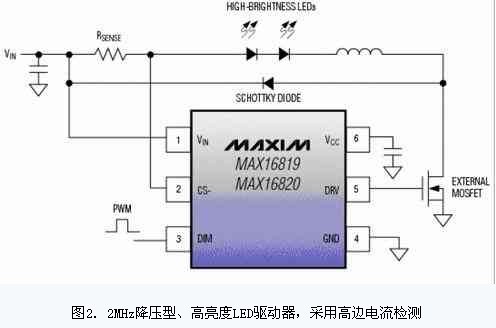
Privacy statement: Your privacy is very important to Us. Our company promises not to disclose your personal information to any external company with out your explicit permission.
With the increasing efficiency of high-brightness LEDs, that is, the increase in lumens/wattage, more and more lighting applications are beginning to choose high-brightness LEDs, such as automotive exterior lights (daytime running lights, low beam lights, high beam lights, etc.) ) and general lighting equipment. LED manufacturers have recently introduced high-brightness LEDs with efficiencies in excess of 80 lumens per watt, so LEDs can be used to replace traditional halogen lamps, such as MR16 spotlights. The transition from traditional halogen lamps to high-brightness LEDs can significantly reduce power consumption and extend product life. According to market research firm Strategies Unlimited, lighting, backlighting and automotive applications will be the main growth drivers for the high-brightness LED market in the next three to five years. By 2011, the entire market will reach $9 billion.
Linear driver
The best solution for driving HBLEDs is to use a constant current source. A simple circuit to implement a constant current source is to use a MOSFET in series with the HBLED to sense the current of the HBLED and compare it to the reference voltage. The comparison signal is fed back to the operational amplifier to control the gate of the MOSFET. This circuit acts as an ideal current source to maintain a constant current during forward voltage and supply voltage changes. Currently, some linear driver chips, such as the MAX16806, as shown in Figure 1, integrate MOSFETs and high-precision voltage references inside the chip to maintain consistent brightness across different illumination devices.

The advantage of a linear driver over a switch mode driver is that the circuit structure is simple and easy to implement, since there is no high frequency switch, so there is no need to consider EMI. The linear driver has fewer external components, which can effectively reduce the overall cost of the system. For example, the input voltage required by the MAX16806 only needs to be 1V higher than the total LED voltage drop. The external current sense resistor measures the current of the LED to ensure that the MAX16806 can output a constant current as the input voltage and LED forward voltage change.
The power consumption of a linear driver is equal to the LED current multiplied by the voltage drop of the internal (or external) passive device. As the LED current or input supply voltage increases, power consumption also increases, limiting the application of linear drivers. To reduce the power consumption of the lighting device, the MAX16806 monitors the input voltage and reduces the drive current to reduce power consumption if the input voltage exceeds a predetermined value. This feature can be used in some applications to avoid switching power supplies, such as car dome lights or daytime running lights, which typically cause the lights to go out when abnormally high battery voltages occur.
Switched buck driver
When the input voltage is much higher than the total voltage drop of the LED, it is best to use a switch mode buck driver, such as the MAX16820, as shown in Figure 2, which minimizes power supply dissipation for higher drive efficiency.

Unlike the general HBLED-driven Buck chip, the MAX16820 uses hysteresis control. There is no control loop compensation, which simplifies the design and helps reduce the number of external components. Integrated high-voltage current-sense amplifiers that operate at switching frequencies up to 2MHz, reducing board space and device count, making the MAX16820 ideal for most LED drivers, such as high-performance LEDs based on MR16, automotive headlamps, and Tail lights, etc.
LED brightness adjustment
Reducing the LED current will reduce the brightness of the LED and its output spectrum will also change. In some applications, this is not recommended. In order to maintain the same spectrum at different brightnesses, it is best to keep the current at the manufacturer's specified value and then chop the output current at a specific frequency or duty cycle. To avoid visual flicker, the frequency should be above 100Hz. The dimming amplitude depends on the minimum period allowed by the LED driver.
Most LED drivers require a brightness control signal generated by a microprocessor or an external timer. The MAX16806 and MAX16831 LED drivers internally generate a 200Hz control signal for LED PWM brightness control. The external PWM signal or analog signal can also be used to adjust the brightness through the DIM pin. In some applications, the introduction of this feature can eliminate the need for a microprocessor.
Reasonable selection of HB LED drivers must understand the requirements of specific LED lighting devices. First, it is necessary to determine electrical parameters such as input voltage, LED current, LED forward voltage and the range of variation of these parameters. Safety, EMI, thermal management, mechanical properties, and board space available are also factors that must be considered. Linear drivers are ideal for applications that require low cost and low EMI. Switching drivers are suitable for applications such as high power, high efficiency, and wide input voltage range, but at a higher cost, EMI issues must be considered. Maxim offers a wide range of solutions for different HB LED applications.
Author:
Mr. Wayne Tang
Phone/WhatsApp:
March 29, 2023
March 21, 2023
Bu tedarikçi için e-posta
Author:
Mr. Wayne Tang
Phone/WhatsApp:
March 29, 2023
March 21, 2023
April 03, 2023
April 03, 2023

Privacy statement: Your privacy is very important to Us. Our company promises not to disclose your personal information to any external company with out your explicit permission.

Fill in more information so that we can get in touch with you faster
Privacy statement: Your privacy is very important to Us. Our company promises not to disclose your personal information to any external company with out your explicit permission.